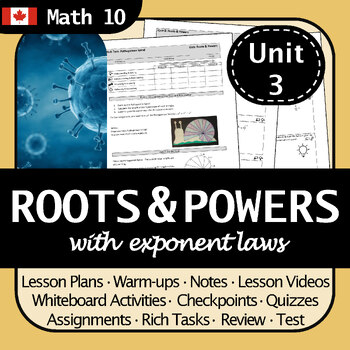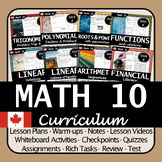BC Math 10 Roots, Powers & Exponent Laws Unit | No Prep! Differentiated!
- Zip
Also included in
- This resource has recently been updated!Are you looking for an entire course plan for BC Foundations of Mathematics and Pre-Calculus 10 curriculum (British Columbia Canada)? This package is for you! The resources were created to help students develop their mathematical curricular competencies and maPrice $149.00Original Price $184.60Save $35.60
Description
This resource was recently updated.
If you are looking for a differentiated, engaging, and hands-on unit on roots, powers, and exponent laws, then this package is for you! No prep necessary!
Everything is fully editable and comes with step-by-step answer keys and links to YouTube lesson videos that match up with the lesson notes.
WHAT SETS THIS RESOURCE APART:
- Formative Assessment Opportunities for Personalized Growth
This unit has multiple formative assessment strategies where students can get specific feedback on their progress. There are also opportunities for students to self-assess and reflect, empowering students to become active in their learning. All questions are marked with icons indicating to students which mathematical competency they are pursuing, aiding their self-directed learning process. - Interactivity and Collaboration
Each unit comes with engaging warm-up ideas and interactive whiteboard activities, which help foster a supportive learning environment. Students will be actively involved and thinking in your classroom. - Differentiation
Cater to diverse learning needs with differentiated daily practice assignments, tiered by difficulty level, allowing every student to challenge themselves and find success. An extension assignment is provided for early finishers as well. - Real-World Connections and Project-Based Learning
The unit includes a variety of authentic real-world applications in the warm-ups, lesson notes, activities, assignments, etc. The rich tasks (mini projects), where students apply their understanding, foster creativity and critical thinking. - Lesson Videos
Links to YouTube lesson videos are included to go with the scaffolded lesson notes. They are a great tool for students who have been absent or who need to review a concept a second time.
WHAT IS INCLUDED:
Every resource is editable and comes with a detailed answer key
· A preview document explaining the purpose and intended use of each resource
· A get ready assignment with examples and practice questions to review prior knowledge
· Detailed Lesson plans, full solution keys, rubrics and exemplars
· 6 Scaffolded Lesson Notes with links to YouTube Lesson Videos
· 5 Sets of Group Practice Task Cards - Whiteboard Questions
· 6 Differentiated Practice Assignments (questions are tiered by difficulty level)
· 5 Checkpoints with self-assessment (to review key questions from each lesson)
· 2 Rich Problem-Solving Task
· Review and Study Guide
· 2 Quizzes with rubrics and keys
· Final unit test with 2 versions + rubrics and keys
MAIN CONCEPTS:
· Perfect squares/cubes and their roots
· Converting between entire and mixed radicals
· Evaluating Powers with rational and negative exponents
· Applying the exponent laws (with and without variables)
This resource was developed for use in British Columbia Canada for the redesigned Foundations of Mathematics and Pre-Calculus 10 curriculum and new reporting order (2023). However, it is also relevant for use in the US and other curriculums. These resources would work well for distance learning or home school.
For more details on what is included, exemplars, and a topic descriptions, please see the preview document.
This product is also part of my BC math 10 curriculum bundle
Check out my other B.C. Math 10 resources:
Entire Course Bundle for FPC 10 (includes all 8 units below)
Unit 4 - Relations and Functions
Unit 6 - Linear Systems of Equations
Unit 8 - Financial Literacy (Earning an Income)
Checkpoints and Task Cards for the Entire Math 10 Course in BC
Click here to become a follower and be the first to hear about my freebies, sales, and new products.
Did you know that you can earn 5% back for future purchases by leaving feedback? I would love to hear from you! Please note that this resource is for use by one teacher only. Colleagues must purchase additional licenses. You may not upload this resource to the internet in any form unless it is password protected for your individual class.
LICENSING TERMS: This purchase includes a license for one teacher only for personal use in their classroom. Licenses are non-transferable, meaning they can not be passed from one teacher to another. No part of this resource is to be shared with colleagues or used by an entire grade level, school, or district without purchasing the proper number of licenses. If you are a coach, principal, or district interested in transferable licenses to accommodate yearly staff changes, please contact me for a quote at 360.maths.360@gmail.com.
COPYRIGHT TERMS: This resource may not be uploaded to the internet in any form, including classroom/personal websites or network drives, unless the site is password protected and can only be accessed by students.






